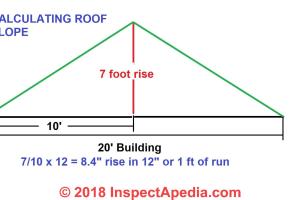Mastering Roof Pitch: A Complete Guide to Calculating and Understanding Roof Angles

-
Quick Links:
- What is Roof Pitch?
- Why is Roof Pitch Important?
- How to Measure Roof Pitch
- Tools for Calculating Roof Pitch
- Different Methods of Calculating Roof Pitch
- Common Mistakes to Avoid
- Real-World Case Studies
- Expert Insights
- FAQs
What is Roof Pitch?
Roof pitch, also known as roof slope, refers to the steepness or angle of a roof. It is typically expressed as a ratio of vertical rise to horizontal run. For example, a pitch of 4:12 means the roof rises 4 inches for every 12 inches of horizontal distance. Understanding roof pitch is crucial for both aesthetic and practical reasons, as it affects water drainage, insulation, and overall structural integrity.
Why is Roof Pitch Important?
The pitch of a roof plays a significant role in several aspects of roofing:
- Water Drainage: A steeper pitch allows for better drainage, reducing the risk of water pooling and leaks.
- Insulation: The design and angle can affect insulation effectiveness, impacting energy efficiency.
- Material Choice: Certain materials are better suited for specific pitches, influencing durability and cost.
- Aesthetic Appeal: Roof pitch contributes to the overall look of a home, affecting curb appeal and market value.
How to Measure Roof Pitch
Measuring roof pitch can be done using several methods. Here’s a step-by-step guide:
- Gather Your Tools: You will need a level, a measuring tape, and a pencil.
- Choose a Reference Point: Select a point on the roof where you can easily measure the rise. This is usually near the edge.
- Level the Measuring Tape: Place the level horizontally from the reference point and extend the measuring tape vertically until it touches the roof. Measure the vertical rise in inches.
- Measure the Horizontal Run: Measure 12 inches horizontally from the same reference point and transfer that measurement straight down to the roof. This will be your run.
- Calculate Your Roof Pitch: Divide the rise by the run to find your pitch ratio. For example, if your rise is 6 inches and your run is 12 inches, your pitch is 6:12.
Tools for Calculating Roof Pitch
Various tools can aid in calculating roof pitch accurately:
- Roof Pitch Finder: A specialized tool designed to measure slope quickly.
- Digital Level: Offers precise measurements and often includes pitch calculations.
- Apps: There are several smartphone apps available that can help measure and calculate pitch.
Different Methods of Calculating Roof Pitch
Besides the manual method described earlier, here are alternative approaches:
1. Using a Roof Pitch Calculator
Online calculators allow you to input rise and run directly to get pitch quickly. Many roofing websites offer these tools for free.
2. Using a Protractor or Angle Finder
For those who prefer a more technical approach, using a protractor can provide an exact angle measurement, which can then be converted to a pitch ratio.
Common Mistakes to Avoid
When calculating roof pitch, avoid these common pitfalls:
- Not measuring accurately, which can lead to incorrect pitch calculations.
- Forgetting to account for different roof sections, especially in complex designs.
- Neglecting the impact of local building codes on acceptable pitch ranges.
Real-World Case Studies
Understanding roof pitch through case studies can provide valuable insights:
Case Study 1: Residential Home
A family in the Midwest decided to replace their roof. By accurately measuring the pitch, they selected a roof material that would withstand heavy snowfall, improving water drainage and reducing future maintenance costs.
Case Study 2: Commercial Building
A commercial property owner opted for a low-slope roof to maximize usable space. By calculating the pitch properly, they ensured adequate drainage while adhering to local building codes.
Expert Insights
We interviewed professional roofers to gather their insights on roof pitch:
John Smith, Roofing Contractor: "Understanding your roof pitch is crucial for anyone planning a roof replacement. It directly impacts material selection and installation methods. Always ensure accurate measurements."
FAQs
1. What is the ideal roof pitch?
The ideal roof pitch varies based on climate and materials but generally ranges from 4:12 to 9:12 for residential homes.
2. How do I convert pitch to degrees?
To convert pitch to degrees, use the formula: degrees = arctan(rise/run) and use a scientific calculator.
3. Can I use any roofing material on a steep pitch?
Not all materials are suitable for steep pitches. Check manufacturer guidelines for compatibility.
4. What are the consequences of an incorrect roof pitch?
Incorrect pitch can lead to water pooling, premature roof failure, and potential structural damage.
5. How can I find the pitch of an existing roof?
You can measure the rise and run using a level and measuring tape, or use a roof pitch finder tool.
6. What is a low-slope roof?
A low-slope roof has a pitch of less than 4:12 and requires special materials for effective water drainage.
7. Why do some roofs have a higher pitch?
A higher pitch is often used in areas with heavy snowfall to prevent accumulation and reduce the risk of leaks.
8. Is calculating roof pitch necessary for DIY roofing?
Absolutely. Accurate pitch calculations are essential for proper material selection and installation techniques.
9. Can roof pitch affect home insurance?
Yes, certain pitches may be more favorable or unfavorable according to insurance policies, impacting coverage rates.
10. Should pitch be considered when buying a home?
Yes, understanding the roof pitch can inform potential buyers about maintenance costs and energy efficiency.
Random Reads